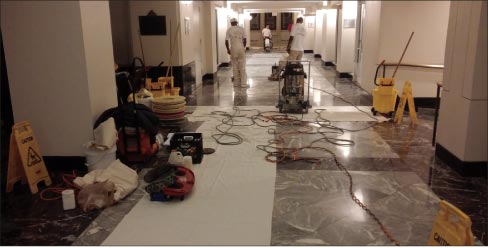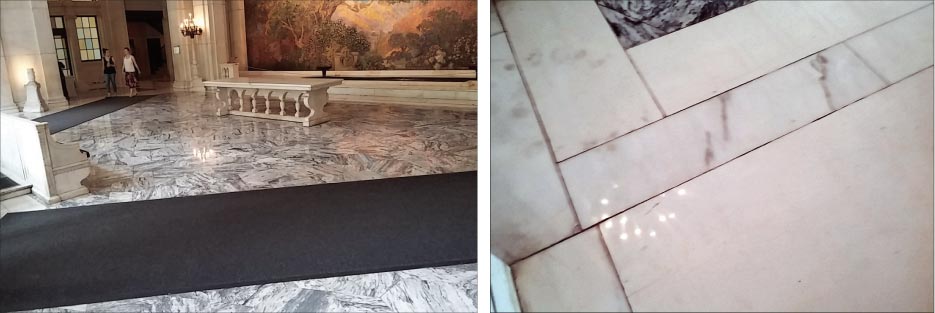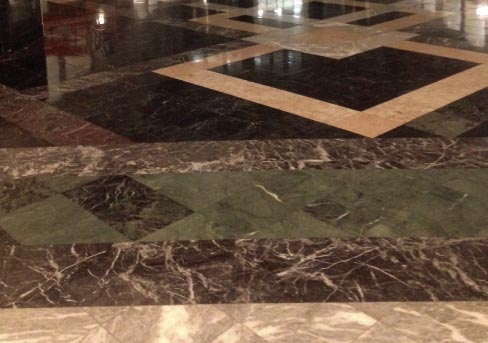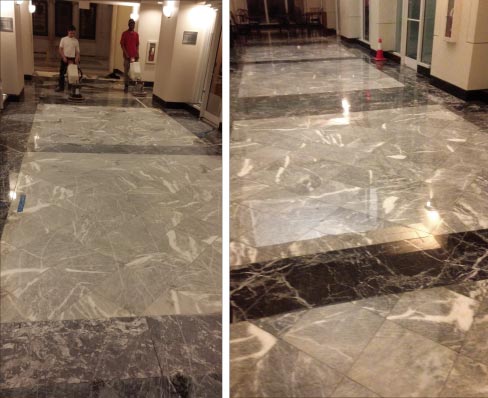The Marble Restoration Company Takes on the Landmark Philly Curtis Center
Peter J. Marcucci
 |
|
Above: The one-of-a-kind waterfall at the Curtis Center presents a unique challenge, especially the curved surfaces. “The decision to restore the waterfall has not been made yet. It’s going to be a long-term project and we are very excited about that!” said Rick Sirianni. |
 |
|
Above, From left: Kas Sanders, Dallas Balanow and Darnell Jason. “Our night guys are all commercial and our day guys have to be able to do mostly residential, which is a lot more detail work and different. But we do a lot more big-time commercial work, so they have to be able to do both. We work on our own training technique and we are always going to have trainees onboard, guys that want to learn the business.” |
Built by 20th century media mogul Cyrus H.K. Curtis, the Curtis Center, completed in 1910, was headquarters of the Curtis Publishing Company. Recognized for publishing such periodicals as American Home, People’s Ledger, Ladies Home Journal and Saturday Evening Post, Curtis Publishing was considered a leading media distributor of the day.
Much to its credit, the company saw decades of success. In the 1940s, due to the advent and growing popularity of a new, competing media form (television), the company began losing advertising revenue. Slowly selling its assets in an effort to stay viable, the company continued to spiral to its demise, like many printing ventures competing with modern media.
Respected and cherished to this day, the Curtis Center, with its renowned atrium and “Dream Garden,” continues to stand as a proud testament to the majestic beauty of the Beaux Arts Style. Now home to gala events and upscale residences, this marvelous achievement in architecture is considered one of Philadelphia’s crown jewels.
Unfortunately, like many works of its time, the Curtis Center wears the scars from decades of use, albeit slight by comparison. Beginning with the atrium, The Marble Restoration Company, located in Lafayette Hill, Pennsylvania, has begun the task of restoring every millimeter of Curtis Center’s natural stone to its original beauty, explained Founder Rick Sirianni. “The floor is massive in terms of scope. Including the atrium, it’s a whole city block!”
Massive, indeed. Measuring a total of 23,000 square feet of patterned marble, the atrium floor features Arabescato Trambiserra, Arabescato Corchia, Thassos, Carrara, Statuary, Negro Marquina, Verde Patricia Scuro, Jerusalem Gold, Rosso Levanto and Marron Emperador.
Rick said that Marble Restoration regularly does work for Keystone Properties, working closely with their managers. “In the case of the Curtis Center, the property manager said, ‘I’d like you to take a look at the floor.’ He wasn’t happy about the way it was being maintained. It was a janitorial company taking care of it, not a marble company, and all they were doing was waxing the floor. It had this really fake-looking shine to it, and the property manager was smart enough to know that it didn’t look right.
 |
|
Left: The Dream Garden by artist Louis Tiffany measures 15 feet high by 49 feet wide and required 100,000 pieces of favrile glass to complete. “The steps leading up to the mosaic area are beat up. We are doing tests to determine how to repair it without removing the stone,” explained Rick Sirianni. Right: Some typical damage, identified for test repair and restoration. |
 |
|
Restoring the Curtis Center atrium floor presents technical problems not commonly experienced in restoration jobs. “The other issue is the mix of marble. The green gets treated differently than the Carrara, which gets treated differently than the brown, and so on. The green needs to be taken up to a higher grit than the Carrara without leaving waves between the two,“ said Rick Sirianni. |
 |
“So after analyzing it and coming up with a game plan, we said listen: ‘We’ve got to get this wax off the floor, there’s a lot of damage done to the marble, and we are going to have to spend two or three months restoring it before we can put it on a maintenance program.’ We convinced them that the best thing to do was a natural restoration and keep it that way, as opposed to continue covering it with wax.
“So we made them a proposal and they accepted it! We bought new equipment, hired a few more employees (11 total, to date) and began by just picking an area of the floor and got going. We are in there every Monday, Tuesday and Wednesday night. A three-year maintenance contract then allows us to go on to a regular program of honing and polishing – mostly the high-traffic areas.”
Identifying Key Issues
One of the things that Rick did was to purchase a walk-behind floor machine. “We are using it to do some of the refinishing. This type of machine required a different kind of training as opposed to a swing floor machine. So while learning to use it, we needed to have some supervisors onsite just to make sure the guys understood that it’s a different technique. That was one of the issues.
“The other issue is the mix of marble. The green gets treated differently than the Carrara, which gets treated differently than the brown, and so on. The green needs to be taken up to a higher grit than the Carrara without leaving waves between the two. Therefore, in some cases, we need to polish the Carrara and then use crystallizer on the green to make the shine really pop. So sometimes a lot of it is trial and error.”
As of yet, Rick and company haven’t replaced any tiles and will do so only if absolutely necessary. If replacement is needed, in lieu of searching out the original quarries, Rick has other ideas: “If needed, we’ll just try and scope around to find a suitable replacement color. I’m not sure if the original quarry locations are even available. That said, we’ve gotten pretty good at crack repairs. Braxton-Bragg has some very good products we’re using for this. K-Bond acrylics are really good. I’ve just ordered some this morning.”
A Successful Business Model Barely 3 Years Old
How does Rick promote and grow his business, you ask? Just minimal advertising, postcards and a determination grow from within, he explained. “Our main strategy for growth has been to develop from the customer base we already have. Dealing with the property management companies that we work with, our strategy has always been the same in that if we could prove ourselves to these guys, and if we could give them great service and great quality at a fair price, there would be a tremendous opportunity to grow. I’m talking about Brandywine Properties, Liberty Property Trust and Keystone Properties. I mean, one property manager will talk about us to another and say that we are doing great. That’s because we always go a little bit above what we’re supposed to do. To me, it’s that little bit of extra that gives us the reputation that helps us grow.
“I just think the story line for us is that it fits our growth and development narrative. Philadelphia has huge potential, and we really are trying to develop this company into a larger and more professional organization because there is so much potential work here. We used to think that we had to grow geographically to grow the company. We have totally, totally changed our perspective on that. There is more than enough growth potential here, not only in the commercial end, but the residential end as well. It would be a great mistake to just concentrate on commercial work. To us, the smart goal is to keep our commercial business at 50 percent and residential at 50 percent. Getting the Curtis Center has really reinforced that we are on the right track and that we’ve got the right business model. If you provide great service and great quality for a fair price, you’re going to be able to grow the company, and it’s working!”
A Glowing Future Etched In Stone
At the time of this interview, Rick had just closed a series of commercial buildings and was booked to full capacity for night work, while the day crew is booked two months ahead.
“We’ve moved a little further north by doing some mailings in the Allentown and Doylestown areas. These are very wealthy districts, and we are doing more business in these locations. I think our next target area will be south New Jersey. We got a lot of play off the Cathedral Basilica of Saints Peter and Paul restoration job (see November SRG issue, page 28). Everyone knows the Pope, and that job gave us a whole lot of credibility. Our close rate on accounts went up 40 percent after that. People just felt more comfortable when saying yes to our proposals.
“I’ve been out for four weeks and you know what, you never would have known that I wasn’t here. (At the time of his interview, Rick was recovering from knee replacement surgery.) They picked up the slack, closed more business, and did a great job! Not only did we survive, but we did better,” he said, laughing.
“Building an organization where people matter has been a lot of fun. I see companies all the time who don’t care about their people. To them it’s all about the bottom line, and I get that, but my sense is that if you take care of your people they will take care of your customers, and a good bottom line will always be there. I’ve got the A-team here. They do a great job, and that’s very comforting to me.”
For more information about The Marble Restoration Company, visit www.marblerestorationco.com .